
Dunkleosteus is an extinct genus of large arthrodire ("jointed-neck") fish that existed during the Late Devonian period, about 382–358 million years ago. It was a pelagic fish inhabiting open waters, and one of the first apex predators of any ecosystem.

Arthrodira is an order of extinct armored, jawed fishes of the class Placodermi that flourished in the Devonian period before their sudden extinction, surviving for about 50 million years and penetrating most marine ecological niches. Arthrodires were the largest and most diverse of all groups of placoderms.

Titanichthys is an extinct genus of giant, aberrant marine placoderm from shallow seas of the Late Devonian of Morocco, Eastern North America, and possibly Europe. Many of the species approached Dunkleosteus in size and build. Unlike its relative, however, the various species of Titanichthys had small, ineffective-looking mouth-plates that lacked a sharp cutting edge. It is assumed that Titanichthys was a filter feeder that used its capacious mouth to swallow or inhale schools of small, anchovy-like fish, or possibly krill-like zooplankton, and that the mouth-plates retained the prey while allowing the water to escape as it closed its mouth. A study has since confirmed this assumption as its jaws are functionally closer to that of filter feeders like baleen whales and basking sharks, and it appears to have developed from benthic durophagists that became pelagic suspension feeders. This would make it the first (known) large-sized vertebrate filter feeder. Titanichthys was estimated to have reached a length of 7–7.6 m (23–25 ft), but Engelman (2023) suggested that Titanichthys was comparable in size to Dunkleosteus, likely measuring about or just over 4.1 metres (13.5 ft) in length.
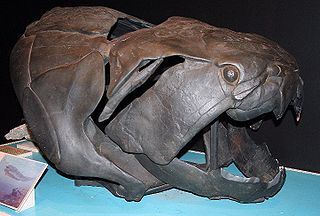
Dunkleosteidae is an extinct family of arthrodire placoderms that lived during the Devonian period. The gigantic apex predator Dunkleosteus terrelli is the best known member of this group.
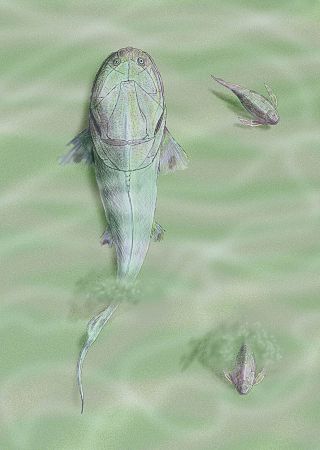
Homosteus is a genus of flattened arthrodire placoderm from the Middle Devonian. Fossils are found primarily in Eifelian-epoch aged strata of Europe, Canada, Greenland, and Estonia. All of the species had comparatively large, flattened heads with, as suggested by the upward opening orbits, upward-pointing eyes. These adaptations suggest that the various species were benthic predators. A study on Titanichthys, in contrast, suggests that species of Homosteus may have been filter-feeders instead.

Holonema is an extinct genus of relatively large, barrel-shaped arthrodire placoderms that were found in oceans throughout the world from the Mid to Late Devonian, when the last species perished in the Frasnian-Fammian extinction event. Most species of the genus are known from fragments of their armor, but the Gogo Reef species, H. westolli, is known from whole, articulated specimens.

Quasipetalichthys haikouensis is the type and only known species of the extinct petalichthid placoderm, Quasipetalichthys. Fossil remains of Quasipetalichthys have been found in the Middle Devonian, Givetian faunal stage of China.
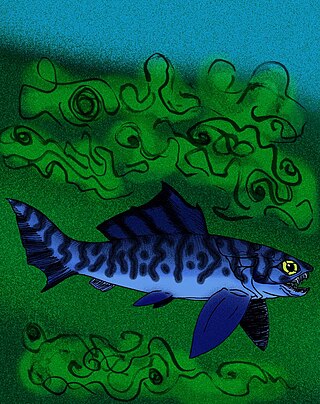
Hadrosteus is an extinct monospecific genus of large arthrodire placoderm from the Late Frasnian Kellwasserkalk facies of Bad Wildungen, Germany. It had large, double-pronged inferognathals, and serrated edges along its mandible, strongly suggesting that it was a fish-eating predator. The head had a triangular snout, and the trunkshield was short, but high, with a median dorsal plate that was broader than wide. The average skull length is about 16 centimeters.
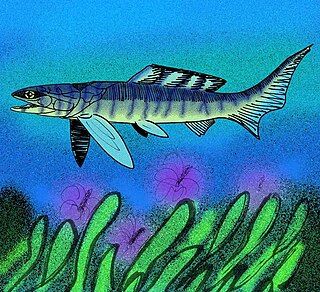
Gymnotrachelus is an extinct monospecific genus of large selenosteid arthrodire placoderm of the Late Devonian known from the Late Famennian Cleveland Shale of Ohio. The type species is Gymnotrachelus hydei.

Diplognathus is a genus of arthrodire placoderm from the Late Famennian Cleveland Shale of Late Devonian Ohio, known only from incomplete fragments of jaws and skulls. What fragments are known suggest that the living animals were large-eyed piscivores with weak, but widely gaping jaws. D. mirabilis is thought to be fairly large, with infragnathals up to 45 centimeters in length. The second species, D. larfargei, was much smaller, with inferognathals averaging about 4 centimeters in length.
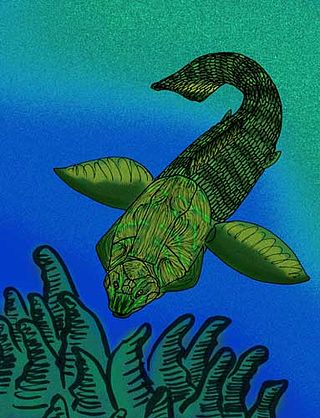
Holonematidae is an extinct family of relatively large arthrodire placoderms from the Early to Late Devonian. Almost all fossil specimens are of armor fragments, though, all have distinctive ornamentation, often of unique arrangements and patterns of tubercles, that are diagnostic of the family. The trunkshield is very elongated, giving the armor an overall "barrel" like appearance.

Rhenonema eifeliense is a large, extinct, high-crested holonematid arthrodire placoderm from Givetian-aged strata of Middle Devonian Gerolstein, Germany. It is known from some fragments of armor, including an anterior-lateral plate estimated to be around 24 centimetres (9.4 in) long, and a portion of a median dorsal plate with a very tall crest running along the median line of the dorsal surface. The ornamentation is very similar to that of Holonema, but the concentrically arranged ridges are much coarser in Rhenonema. The holotype was originally described by Kayser, in 1880, as a species of Dinichthys, but was then redescribed in 1964 by Obruchev as a holonematid.

Protitanichthys is an extinct genus of comparatively large coccosteid arthrodire placoderms from the Middle Devonian of the eastern United States. Fossils are found primarily in the Eifelian-epoch aged Delaware Limestone of Ohio, and the Lower Givetian-aged Rockport Quarry Limestone of Michigan

Homostiidae is a family of flattened arthrodire placoderms from the Early to Middle Devonian. Fossils appear in various strata in Europe, Russia, Morocco, Australia, Canada and Greenland.
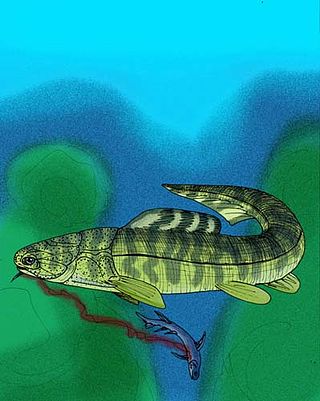
Buchanosteidae is a family of arthrodire placoderms that lived from the Early to Middle Devonian. Fossils appear in various strata in Russia, Central Asia, Australia, and China.

Heterosteidae is an extinct family of moderately large to giant, flattened, benthic arthrodire placoderms with distinctive, flattened, triangular skulls that are extremely broad posteriorly, but become very narrow anteriorly.

Aspidichthys is a genus of large, distinctively tuberculated arthrodire placoderm of uncertain affinities from Upper Devonian marine strata in the Eastern United States and Europe.
Heightingtonaspis is an extinct genus of primitive arthrodire placoderm fish from the Devonian period in Great Britain, and currently contains three species.

Herasmius is an extinct genus of heterosteid placoderm from the Devonian period. Fossils have been discovered freshwater deposits in Norway and Canada.

Tityosteus is an extinct genus of homostiid arthrodire from the Early Emsian of the Early Devonian, with fossils known from Germany, the Ibero-Armorican Trough, and southern Siberia. It attained a length of 2.5 meters.



























